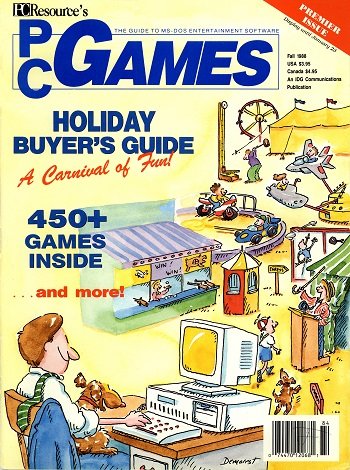
PCGames was a US publication dedicated to what it said on the cover: games for the personal computer. Originally a quarterly spin-off publication from PC Resource magazine that appeared on store shelves in Autumn of 1998, PCGames quickly took on a life of its own, outlasting its parent magazine and undergoing several name changes: it was Electronic Entertainment in 1993, morphed to PC Entertainment for five issues in 1996, then finally settled on PC Games (note the space in there) from June of 1996 until April of 1999 when the magazine was absorbed by competitor PC Gamer, ceased publication, and few people noticed because of this thing called "the internet".
Since we're coming up on the 30th anniversary of the creation of...um...the magazine that eventually became PC Games, I figured it might be fun to do the timewarp again and see what was big in the world of computer entertainment in 1988, what people predicted, and how well a bunch of serious business types handled the transition to writing about games instead of debunking rumors about waxing internal components to make your computer go faster. Join me for a truly exciting(?) read through the premiere issue of PCGames magazine!
One of the most fun thing about looking through old magazines in general, but old game magazines in particular, is the ads. If you were alive back when the magazine was printed, you likely remember a few of these titles--maybe you played them at a friend's house, maybe you played them when your parents weren't watching, maybe you were old enough to have a job and buy them yourself. Maybe you were a filthy one-eyed, peg-legged, hook-handed jackwagon of a character known as a 'software pirate' and felt other peoples' booty was yours for the claimin'. I dunno, it was the 80's. I remember what I wore back then; I'm not gonna judge.
One thing you have to be prepared for though is the absolute deluge of ads you see in any gaming publication. This first issue of PCGames carried a $3.95 cover price for what is exactly 100 pages cover to cover, but of those one hundred pages, forty-seven of them (including the back cover) are full-page ads. There's another handful of 1/4-page to 1/2-page ads sprinkled throughout, meaning better than half the magazine is meant to sell you something other than the magazine. There's no letter column for readers yet, this being the first issue and all, but if letter columns from other gaming periodicals of the time are any clue, I expect to see this become a common complaint very quickly.
For reference, these are the first things you see upon opening the magazine:


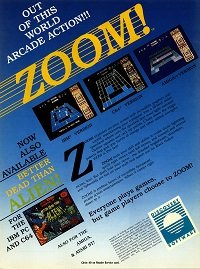
I know the cover promises 450+ Games Inside, but...
So before you reach the table of contents, your PC overlords would like you to consider extreme mountain climbing, gambling, and...whatever the hell Zoom is. So: wind up in traction, lose all my money, and, um, "Outline squares and rack up points." Got it. I'll get right on that.
When Hell freezes over.
(Spoiler alert: there's more ad talk at the end of the article!)
Enough about ads. Let's get to the meaty parts and see what's shakin' the editors' bits and bytes this issue!
Step Right Up
The introductory editorial of the issue is entitled, "The Adventure That Started an Avalanche". Editor in Chief Chuck Weston reflects on Colossal Cave, aka Adventure, the very first text adventure most computer gaming enthusiasts, myself included, played, and traces its history from college campuses (where playing it was restricted to 'after-hours', resulting in students staying up all hours of the night playing it then wandering, bleary eyed, to their classes the next day after little, if any sleep) to home and business computers of today ('88) which have much larger memory reserves and faster CPUs to allow for fancy graphics instead of just plain text. The ripples cast by Adventure's pebble tossed into computer gaming's pond now span literal decades, having overseen the rise and demise of countless studios, the inspiration of software outfits like Infocom who raised the text adventure to an unequaled artform, and the concurrent design and rise of other types of games. It's a great welcome to the magazine, and breaks down the PCGames mission statement into simple, digestible chunks:
In the following pages we will lead you through a veritable carnival of computer game software, with occasional side trips to the land of technology. When our tour is over, we trust that you will be able to cut through the hype and hoopla and know what kind of entertainment products you want to spend your hard-earned money on. Welcome to PCGames.
Welcome indeed!
Hooked on Games
What is it about computer games that turns ordinary people into wide-eyed zealots?
So asks freelancer Eric Grevstad, who proceeds to answer his own question in this two-page column. It's a simple opinion piece, as opposed to a scientific paper delving into the habits and addictive personalities of those truly driven to game at all costs, but the bottom line, he concludes, is that games let us do things we might never be able to do in real life, like drive an F1 car around the race track, or land a plane at Chicago's O'Hare airport. No mention of dopamine hits or other things, but he does bring up the "next time I'll get it for sure" mentality inherent in gamers who enjoy casual fare like Tetris. Also, I know this is a magazine about MS-DOS games, but Grevstad poo-poos the arcades (apparently under the assumption they all died in the early part of the decade with the passing of Pac-Man and Space Invaders, and not realizing there's still a robust scene there) and flat-out ignores the emergence of dedicated gaming consoles like the NES and Sega Master System, which had been around for three years at this point. Overlooking the Master System isn't surprising, and Atari's 2600 was still struggling after the crash of '83, but by Fall of '88, Nintendo was penetrating the market like it was a spread-legged porn star, even if adults still saw the NES as just a kids' toy.
An Interview With Steve Cartwright
"This whole industry is in its infancy. Five or six years is nothing in an industry, and it's only going to get better."
Who is Steve Cartwright? Well, if you remember your 2600 days at all, you can thank him for creating Barnstorming, which people are still speedrunning and optimizing today. Accolade poached him from Activision and, at the time this article was written, he was serving as a senior game designer on Fastbreak. He went on to EA where he worked on the Tiger Woods series among others. Today, he serves a UI/UX Designer for Nimble Collective, Inc.
Interviews are always awesome, because unlike other content like product reviews, they don't date anywhere near as quickly. This interview is a bit different than I'm used to, as we don't see the questions interviewer Leon Beaulieu asked him, just his answers, broken down and grouped into categories. Cartwright dishes on normal topics like his education and past, offers up his thoughts on the current state of games, what the widespread adoption of MS-DOS means for the gaming scene, and where the industry might be going with regards to on-disk copy protection. This is a top-notch read, and probably the most important article from a historical standpoint in the issue.
An Initial Look At Video Resolution
RGB, CGA, EGA, VGA: Here's a layman's guide to the abbreviated world of graphics standards.
Eric Grevstad's back to teach yon graphical novices what all those silly letter combinations mean and how they apply to your home gaming experience. While I'm sure this was a great read for the day, it's extremely outdated for the world of graphics drivers, 3D cards, automatic settings detection, and the plug-and-play experience we've all grown to expect. But the line from this one that aged the worst has to be the concluding sentence: "The best bet is to bring your laptop and try out the software at the dealer before you buy."
Yes, kids, there was a time when you could drag your own hardware to a software shop and test the product before you committed your cash, broke the seal, and voided your chance to return it for a refund. And given the rise of digital distribution platforms like GOG.com and Steam, actually visiting the store to buy your computer games feels about as antiquated.
Damn, I'm old.
The Indisputable Element
For arcade play or vehicle simulation, there's no substitute for a joystick.
Chuck Weston returns to the fray for this three-page test drive of eight different joysticks, breaking down the best uses for them and the pitfalls to look out for.
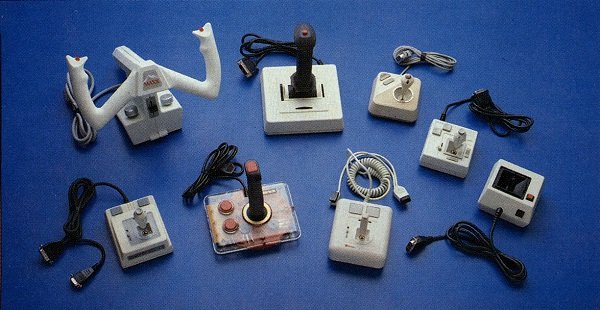
Man, remember life before control pads? ^_^
The Midway
Categorizing entertainment software packages is an almost impossible task.
Editors Lou Wallace, Dan Muse, Lafe Low (yes, that's really his name), Guy Wright, and Bob Ryan all tackle the biggest article in the magazine: this massive 27-page feature on games from every genre: racing, driving, flying, action, adventure, fantasy, simulation, point-and-click, even (gasp!) an adult title.
Don't get excited, it's just Leisure Suit Larry in the Land of the Lounge Lizards from Sierra.
These aren't reviews, just run-downs of games either freshly released or on the horizon that hit the high points of what each piece of software sets out to do and features. It's the holiday buyer's guide advertised on the cover. Unfortunately, due to the presentation style and the fact that there's literally one page of ads for every one page of content, this section feels like an enormous catalog rather than a feature in its own right.
Lists like these were important back in the day, since almost nobody was online, and publishers relied on editors passing on this information in the pages of their publications. Otherwise how would you ever know The President Is Missing!, uncover Nobunaga's Ambition, or sit down for a friendly game with The Chessmaster 2000?
Buyer's guides are the fastest-dating material from any magazine, and sadly that's what the back half of the issue is all about. While this was good info for December of 1988, there's nothing among these pages that cannot be found elsewhere, and more in-depth, today.
What I Did On My Simulated Vacation
If you can simulate everything else in life, why not your vacation?
Columnist Bud Sadler gets the closing remarks with this one page editorial, an amusing anecdote about using his computer to take a "virtual summer vacation". Instead of booking rooms, dealing with traffic, and fighting the bustle of the tourist traps, Sadler instead loaded himself down with a slew of PC games that let him travel the world and attempt things no middle-aged office worker has any business attempting. Cliff diving in Acapulco, anyone?
According to Sadler's calculations, the actual vacation his family took cost him a total of $669 between lodging, gas, food, souvenirs, and (of course) beer. Going 'virtual' with his vacation, by contrast, cost him only $668 for software and (of course) beer. He's got some explaining to the wife to do though. Was it worth the dollar saved? Sadler doesn't say...only that he's wondering where to find a virtual family.
Give it a decade or so, Bud, and Will Wright will be along to save the day with The Sims. Good luck in the meantime!
The Best Ad
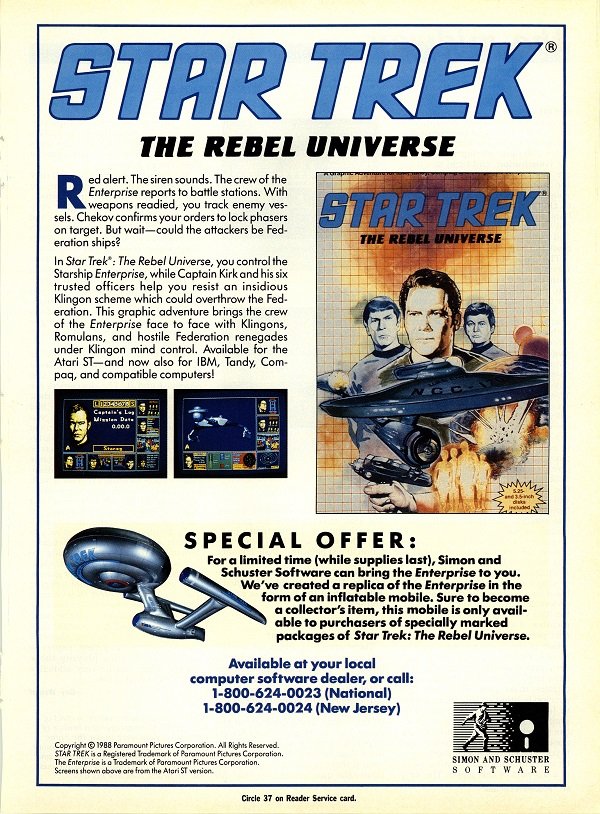
It's hard to argue with Star Trek, but what sealed the deal for me is the blow-up U.S.S. Enterprise offer. I mean, who cares how good the game is (pretty darn good as it turns out) when you too can fly the flagship of Starfleet around your own yard.
Beam me up, y'all!
The Worst Ad
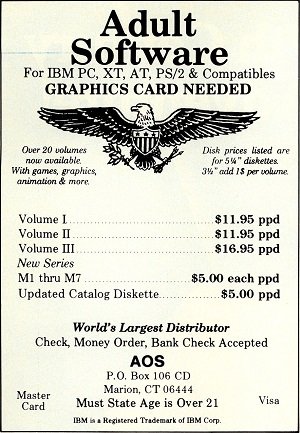
Not only is this a mere 1/4 page, not only does it completely fail to explain what it's offering ("Gee, I think M6 might be just what I'm looking for!" said no one ever...), not only does it charge you five freakin' bucks for a disk-based catalog (or $6 if you need it on a 3.5" floppy--read the fine print!), but you must state you are over 21 years old when placing your order.
What the literal hell are you selling, AOS: pornography or liquor? I swear I'm over twenty-one.
You can tell me.
And that's that! If you enjoyed this trip through 1988 nostalgia and would like to see more, thank @retroroom and @terry93d, and @darth-azrael for requesting more game-related content and magazine write-ups on my channel blog page account, then hit me with your best (upvote) shot and leave a comment.
What will I write about next? I've had suggestions to review the TV series Millennium on laserdisc, talk about classic toys of the 80's, write up more stuff about Dungeons & Dragons, and delve into the mystery of Game Genie cheat codes. If you've got suggestions to add, by all means, join the conversation! :D
Thanks for reading, and I'll see you next time.
Hi @modernzorker, I like the cover somehow... and it looks like a really cosy time then 😊 And I really had to laugh about the idea of the simulated vacations - I guess I'd prefer the even older type of it ☺️
Have you seen my idea of the repository links within my upvote game? Do you like it? It doesn't work so well so far - but maybe it needs a while. It's still in evolution 😌 @peekbit
yes - a nice post again...
I forgot how many ads these old magazines had. I was amazed, reading the first issue of EGM2 (how do you superscript?) that practically every other page was an advertisement. Very nice in its time, I'm sure, but reading from the perspective of the 21st Century (or even just five years after), it's sometimes irritating.
Hi modernzorker,
Visit curiesteem.com or join the Curie Discord community to learn more.
@trufflepig
Holy mother of incomes. You did it, man! You broke into the big leagues!
Check out my page. If you love business, money , and entrepreneurship you will love my content.